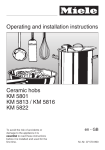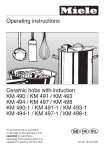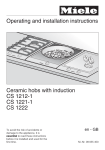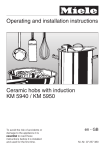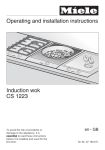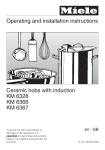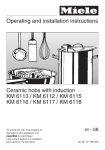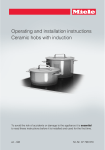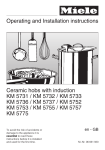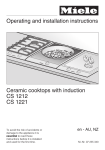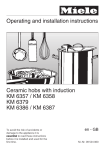Download Operating instructions - Miele Appliances Ltd.
Transcript
Operating and installation instructions Ceramic hobs with induction CS 1212 CS 1221 CS 1234 To avoid the risk of accidents or damage to the appliance, it is essential to read these instructions before it is installed and used for the first time. en - GB M.-Nr. 07 180 660 Contents Guide to the appliance . . . . . . . . . . . . . . . . . . . . . . . . . . . . . . . . . . . . . . . . . . . . . 4 CS 1212 . . . . . . . . . . . . . . . . . . . . . . . . . . . . . . . . . . . . . . . . . . . . . . . . . . . . . . . . . . 4 CS 1221 . . . . . . . . . . . . . . . . . . . . . . . . . . . . . . . . . . . . . . . . . . . . . . . . . . . . . . . . . . 5 CS 1234 . . . . . . . . . . . . . . . . . . . . . . . . . . . . . . . . . . . . . . . . . . . . . . . . . . . . . . . . . . 6 Display . . . . . . . . . . . . . . . . . . . . . . . . . . . . . . . . . . . . . . . . . . . . . . . . . . . . . . . . . . . 7 Cooking zones . . . . . . . . . . . . . . . . . . . . . . . . . . . . . . . . . . . . . . . . . . . . . . . . . . . . . 7 Warning and Safety instructions . . . . . . . . . . . . . . . . . . . . . . . . . . . . . . . . . . . . . 9 Caring for the environment . . . . . . . . . . . . . . . . . . . . . . . . . . . . . . . . . . . . . . . . . 16 Before using for the first time. . . . . . . . . . . . . . . . . . . . . . . . . . . . . . . . . . . . . . . 17 Induction . . . . . . . . . . . . . . . . . . . . . . . . . . . . . . . . . . . . . . . . . . . . . . . . . . . . . . . . 18 The induction principle . . . . . . . . . . . . . . . . . . . . . . . . . . . . . . . . . . . . . . . . . . . . . 18 Noises . . . . . . . . . . . . . . . . . . . . . . . . . . . . . . . . . . . . . . . . . . . . . . . . . . . . . . . . . . 19 Pans . . . . . . . . . . . . . . . . . . . . . . . . . . . . . . . . . . . . . . . . . . . . . . . . . . . . . . . . . . . . 20 Operation . . . . . . . . . . . . . . . . . . . . . . . . . . . . . . . . . . . . . . . . . . . . . . . . . . . . . . . 21 Switching on and off . . . . . . . . . . . . . . . . . . . . . . . . . . . . . . . . . . . . . . . . . . . . . . . 21 Residual heat indicator . . . . . . . . . . . . . . . . . . . . . . . . . . . . . . . . . . . . . . . . . . . . . 21 Settings . . . . . . . . . . . . . . . . . . . . . . . . . . . . . . . . . . . . . . . . . . . . . . . . . . . . . . . . . 22 Auto heat-up . . . . . . . . . . . . . . . . . . . . . . . . . . . . . . . . . . . . . . . . . . . . . . . . . . . . . 23 Booster function . . . . . . . . . . . . . . . . . . . . . . . . . . . . . . . . . . . . . . . . . . . . . . . . . . . 24 Keeping warm . . . . . . . . . . . . . . . . . . . . . . . . . . . . . . . . . . . . . . . . . . . . . . . . . . . . 26 Tips on saving energy . . . . . . . . . . . . . . . . . . . . . . . . . . . . . . . . . . . . . . . . . . . . 27 Safety features . . . . . . . . . . . . . . . . . . . . . . . . . . . . . . . . . . . . . . . . . . . . . . . . . . . 28 Safety lock . . . . . . . . . . . . . . . . . . . . . . . . . . . . . . . . . . . . . . . . . . . . . . . . . . . . . . . 28 Safety switch-off. . . . . . . . . . . . . . . . . . . . . . . . . . . . . . . . . . . . . . . . . . . . . . . . . . . 28 Overheating protection . . . . . . . . . . . . . . . . . . . . . . . . . . . . . . . . . . . . . . . . . . . . . 29 Cleaning and care . . . . . . . . . . . . . . . . . . . . . . . . . . . . . . . . . . . . . . . . . . . . . . . . 30 Problem solving guide . . . . . . . . . . . . . . . . . . . . . . . . . . . . . . . . . . . . . . . . . . . . 32 Optional accessories . . . . . . . . . . . . . . . . . . . . . . . . . . . . . . . . . . . . . . . . . . . . . . 34 2 Contents Safety instructions for installation . . . . . . . . . . . . . . . . . . . . . . . . . . . . . . . . . . . 35 Appliance and building-in dimensions . . . . . . . . . . . . . . . . . . . . . . . . . . . . . . . 39 CS 1212 . . . . . . . . . . . . . . . . . . . . . . . . . . . . . . . . . . . . . . . . . . . . . . . . . . . . . . . . . 39 CS 1221 . . . . . . . . . . . . . . . . . . . . . . . . . . . . . . . . . . . . . . . . . . . . . . . . . . . . . . . . . 40 CS 1234 . . . . . . . . . . . . . . . . . . . . . . . . . . . . . . . . . . . . . . . . . . . . . . . . . . . . . . . . . 41 Preparing the worktop . . . . . . . . . . . . . . . . . . . . . . . . . . . . . . . . . . . . . . . . . . . . . 42 Installation of several appliances. . . . . . . . . . . . . . . . . . . . . . . . . . . . . . . . . . . . 43 Fixing the spring clamps and spacer bars . . . . . . . . . . . . . . . . . . . . . . . . . . . . 45 Installing the appliance(s) . . . . . . . . . . . . . . . . . . . . . . . . . . . . . . . . . . . . . . . . . . 47 General installation tips . . . . . . . . . . . . . . . . . . . . . . . . . . . . . . . . . . . . . . . . . . . 48 Electrical connection . . . . . . . . . . . . . . . . . . . . . . . . . . . . . . . . . . . . . . . . . . . . . . 49 After sales service, data plate . . . . . . . . . . . . . . . . . . . . . . . . . . . . . . . . . . . . . . 52 3 Guide to the appliance CS 1212 a Cooking zone with twin booster (BI/II) Cooking zone controls: b Cooking zone with single booster (Bl) f Rear c Display g Front d Cooking zone symbols e Indicators Indicators l In-operation indicator m Booster indicator n Residual heat indicator 4 Guide to the appliance CS 1221 a Cooking zone with twin booster (BI/II) Indicators b Display c Indicators d Control l In-operation indicator m Booster indicator n Residual heat indicator 5 Guide to the appliance CS 1234 abd Cooking zones with single booster (BI) c Cooking zone with twin booster (BI/II) e Cooking zone symbols f Indicators Cooking zone controls: g Rear right h Front right i Rear left j Front left k Display Indicators l In-operation indicator m Booster indicator n Residual heat indicator 6 Guide to the appliance Display ß = No pan on cooking zone or pan unsuitable A = Auto heat-up I = Booster I II = Booster II (only for cooking zones with twin boosters) L = Safety lock (see "Safety features") Cooking zones Cooking zone CS 1212 minimum to maximum C in cm* Front Rear Rating in watts for 230 V** 10 - 16 normal: with booster: 1400 1800 16 - 23 normal: with Booster I: with Booster II: 2300 3000 3700 Total: 3700 * Pans of any diameter within the given range may be used. ** The wattage quoted may vary depending on the size and material of the pans used. 7 Guide to the appliance CS 1221 minimum to maximum C in cm* 18 - 30 Rating in watts for 230 V** normal: with Booster I: with Booster II: Cooking zone 2400 3000 3700 CS 1234 minimum to maximum C in cm* Rating in watts for 230 V** Front left 14 - 19 normal: with booster: 1850 2900 Rear left 14 - 19 normal: with booster: 1850 2900 Rear right 16 - 23 normal: with Booster I: with Booster II: 2300 3000 3700 Front right 10 - 16 normal: with booster: 1400 1800 Total: 7400 * Pans of any diameter within the given range may be used. ** The wattage quoted may vary depending on the size and material of the pans used. 8 Warning and Safety instructions Correct application This appliance complies with current safety requirements. Inappropriate use can, however, lead to personal injury and damage to property. To avoid the risk of accidents and damage to the appliance, please read these instructions carefully before installation and before using it for the first time. They contain important notes on installation, safety, use and maintenance. Keep these instructions in a safe place and ensure that new users are familiar with the content. Pass them on to any future owner. ~ This appliance is not designed for commercial use. It is intended for use in domestic households and in similar working and residential environments such as: – Shops – Offices and showrooms and by residents in establishments such as: – Hostels and guest houses. ~ The appliance is intended for domestic use only to cook food and keep it warm. Any other use is not supported by the manufacturer and could be dangerous. Miele cannot be held liable for damage resulting from incorrect or improper use or operation of the appliance. ~ This appliance is not intended for use by people with reduced physical, sensory or mental capabilities, or lack of experience and knowledge, unless they are supervised whilst using it, or have been shown how to use it by a person responsible for their safety. 9 Warning and Safety instructions Safety with children ~ Activate the safety lock to ensure that children cannot switch on the appliance inadvertently. ~ This appliance is not a toy! To avoid the risk of injury, keep children away from it all times, and do not let them play with it or use the controls. They will not understand the potential dangers posed by it. They should be supervised whenever you are working in the kitchen. ~ Older children may use the appliance only when its operation has been clearly explained to them and they are able to use it safely, recognising the dangers of misuse. ~ The appliance gets hot when in use and remains hot for quite a while after being switched off. To safeguard against burning, keep children well away from the appliance at all times. ~ Do not store anything which might arouse a child's interest in storage areas above or next to the hob. Otherwise they could be tempted into climbing onto the appliance with the risk of burning themselves. ~ Keep all pans out of reach of children. Turn pan handles inwards away from the edge of the hob. Danger of burning or scalding. Special hob guards are available from good retail outlets. 10 ~ Packaging, e.g. cling film, polystyrene and plastic wrappings, must be kept out of the reach of babies and young children. Danger of suffocation. Dispose of or recycle all packaging safely as soon as possible. Warning and Safety instructions Technical safety ~ Before installation, check the appliance for visible signs of damage. Do not use a damaged appliance. It could be dangerous. ~ The electrical safety of this appliance can only be guaranteed when continuity is complete between it and an effective earthing system which complies with local and national safety regulations. It is most important that this basic safety requirement is present and regularly tested, and where there is any doubt, the household wiring system should be inspected by a qualified electrician. Miele cannot be held liable for the consequences of an inadequate earthing system (e.g. electric shock). ~ Before connecting the appliance, make sure that the connection data on the data plate (voltage and frequency) match the mains electricity supply. This data must correspond in order to avoid the risk of damage to the appliance. Consult a qualified electrician if in any doubt. ~ Do not open the casing of the appliance. Tampering with electrical connections or components and mechanical parts is highly dangerous to the user and can cause operational faults. ~ Installation, maintenance and repairs may only be carried out by a suitably qualified and competent person in strict accordance with current national and local safety regulations. Repairs and other work by unqualified persons could be dangerous. Miele cannot be held liable for unauthorised work. ~ During installation, maintenance and repair work, the appliance must be disconnected from the mains electricity supply. Ensure that power is not supplied to the appliance until after it has been installed or until after any maintenance or repair work has been carried out. ~ For safety reasons, this appliance may only be used after it has been built in. 11 Warning and Safety instructions ~ While the appliance is under guarantee, repairs should only be undertaken by a service technician authorised by Miele. Otherwise the guarantee is invalidated. ~ Faulty components must only be replaced by genuine Miele original spare parts. The manufacturer can only guarantee the safety of the appliance when Miele replacement parts are used. ~ If the connection cable is damaged, it must be replaced by a suitably qualified electrician with a specialist connection cable of type H 05 V V-F (pvc insulated), available from the Miele Spare Parts Department. ~ Do not connect the appliance to the mains electricity supply by a multi-socket adapter or an extension lead. These do not guarantee the required safety of the appliance (e.g. danger of overheating). ~ Do not use the hob if it is faulty, or if the ceramic surface is cracked, chipped or damaged in any way. Switch it off immediately, and disconnect it from the mains electricity supply. Danger of electric shock. 12 ~ This appliance may be connected via a fused plug and switched socket. If you wish to connect it to an isolator switch, or if the appliance is supplied without a plug, it must be installed and connected by a suitably qualified and competent person in strict accordance with current local and national safety regulations. Miele cannot be held liable for damage caused by incorrect installation or connection. ~ In areas which may be subject to infestation by cockroaches or other vermin, pay particular attention to keeping the appliance and its surroundings in a clean condition at all times. Any damage caused by cockroaches or other vermin will not be covered by the guarantee. Warning and Safety instructions Correct use ~ For people fitted with a heart pacemaker: Please note that the area immediately surrounding the hob is electromagnetically charged. It is unlikely to affect a pacemaker. If in any doubt, consult the manufacturer of the pacemaker or your doctor. ~ To prevent damage to items which are susceptible to magnetic fields, e.g. credit cards, diskettes, pocket calculators etc, do not leave them in the immediate vicinity of the hob. ~ The appliance gets hot when in use and remains hot for quite a while after being switched off. There is a danger of burning until the residual heat indicators go out. ~ Do not leave the appliance unattended whilst it is in use. Pans that have boiled dry can cause damage to the ceramic surface for which Miele cannot be held liable. Boiling fat or oil could ignite and cause a fire. ~ If oil or fat does catch fire, do not attempt to put out the flames with water. Use a suitable fire blanket, saucepan lid, damp towel or similar to smother the flames. ~ Use heat-resistant pot holders or gloves when using the appliance. Do not let them get damp or wet, as this causes heat to transfer through the material more quickly with the risk of scalding or burning yourself. ~ Do not flambé under a cooker hood. The flames could set the cooker hood on fire. ~ Do not use the appliance as a resting place for anything else. Take particular care never to place cutlery or other metal objects on the appliance. When the appliance is switched on either deliberately or by mistake, or when there is residual heat present, there is the risk of metal objects heating up, with a danger of burning. Depending on the material, other objects left on the hob could also melt or catch fire. Damp pan lids might adhere to the ceramic surface and be difficult to dislodge. Switch the cooking zones off after use. ~ Where several appliances are installed side by side Do not place hot pots or pans on the joining strip as this can damage the seal. ~ Do not cover the appliance, e.g. with a cloth, kitchen foil, etc. This could be a fire hazard if the appliance were switched on by mistake. 13 Warning and Safety instructions ~ Do not use plastic or aluminium foil containers These melt at high temperatures and could catch fire. ~ Do not heat up unopened tins of food on the hob, as pressure will build up in the tin, causing it to explode. This could result in injury and scalding or damage. ~ Do not use pots and pans on the ceramic hob with bases with pronounced edges or ridges, e.g. cast iron pans. These could scratch or scour the hob surface permanently. ~ Never heat an empty pan unless the manufacturer of the pan expressly states that you can do so. Because induction heating works extremely quickly the base of the pan could heat up to the temperature at which oil or fat self-ignites within a very short time. ~ Keep the hob clean. Grains of salt, sugar and sand (e.g. from cleaning vegetables) can cause scratches. ~ Do not place hot pans on the area around the display. This could damage the electronic unit underneath. ~ Do not drop anything on the ceramic surface. Even a light object could cause damage in certain circumstances. 14 ~ Do not allow either solid or liquid sugar, or pieces of plastic or aluminium foil to get onto the cooking zones when they are hot. If this should occur, switch off the appliance, and carefully scrape off all the sugar, plastic or aluminium residues from the hob whilst they are still hot, using a shielded scraper blade. Take care not to burn yourself. If residues were allowed to cool before being removed, the ceramic surface would be susceptible to pitting or even cracking. Clean the appliance once it has cooled down. ~ When using an electrical appliance, e.g. a hand-held food blender, near the appliance, ensure that the cable of the electrical appliance cannot come into contact with the hot appliance. The insulation on the cable could become damaged, giving rise to an electric shock hazard. ~ This appliance is fitted with a cooling fan. If a drawer is fitted directly underneath the hob, ensure that there is sufficient space between the drawer and its contents and the underside of the appliance in order to ensure sufficient ventilation for the hob. Do not store pointed or small items or paper in the drawer. They could get in through the ventilation slots or be sucked into the housing by the fan and damage the fan or impair cooling. Warning and Safety instructions ~ Spray canisters, aerosols and other inflammable substances should not be stored in a drawer under the hob. Cutlery inserts must be heat-resistant. ~ This appliance must not be set up or ~ Metal utensils stored in a drawer under the hob can become hot if the induction hob is used intensively for a long time. Miele cannot be held liable for damage caused by non-compliance with these Warning and Safety instructions. operated in the open air. ~ Always ensure that food is sufficiently cooked or reheated. Some foods may contain micro-organisms which are only destroyed by thorough cooking at a sufficiently high temperature for long enough. Therefore, when cooking or reheating food such as poultry, it is particularly important that the food is completely cooked through. If in doubt, select a longer cooking or reheating time. ~ Do not use two pans on a cooking zone at the same time. ~ If the appliance is installed behind a kitchen furniture door, it may only be used with the furniture door open. Only close the door when the appliance is switched off and the residual heat indicators have gone out. ~ If the hob is built in over a pyrolitic oven, the hob should not be used whilst the pyrolitic process is being carried out, as this could trigger the overheating protection mechanism on the hob (see relevant section). 15 Caring for the environment Disposal of the packing material The transport and protective packing has been selected from materials which are environmentally friendly for disposal, and should be recycled. Ensure that any plastic wrappings, bags, etc. are disposed of safely and kept out of the reach of babies and young children. Danger of suffocation. Disposal of your old appliance Electrical and electronic appliances often contain materials which, if handled or disposed of incorrectly could be potentially hazardous to human health and to the environment. They are, however, essential for the correct functioning of your appliance. Please do not therefore dispose of it with your household waste. Please dispose of it at your local community waste collection/recycling centre or contact your dealer for advice. Ensure that it presents no danger to children while being stored for disposal. 16 Before using for the first time Please stick the extra data plate for the appliance supplied with this documentation in the space provided in the "After sales service, data plate" section of this booklet. Cleaning for the first time ^ Remove any protective wrapping and adhesive labels. ^ Before using for the first time, clean the appliance with a damp cloth only and then wipe dry. Do not use washing up liquid to clean the ceramic surface as it can leave a blue sheen which may be difficult to remove. Before using for the first time When the induction hob is first connected, and after a power cut, all of the indicators in the display light up for approx. 1 second for testing purposes. The appliance can be used as soon as the indicators go out. When the appliance is used for the first time, it may give off a slight smell and some vapours. This smell will be less noticeable with each subsequent use before dissipating completely. The smell and any vapours given off do not indicate a faulty connection or appliance and they are not hazardous to health. Please note that the heating up time on induction hobs is very much shorter than on conventional hobs. 17 Induction The induction principle An induction coil is located under each cooking zone. When a cooking zone is switched on, this coil creates a magnetic field which impacts directly on the base of the pan and heats it up. The cooking zone itself is heated up indirectly by the heat given off by the pan. An induction cooking zone only works when a ferromagnetic pan is placed on it (see "Pans"). Induction automatically recognises the size of the pan, i.e. heat is only generated in the area covered by the base of the pan. The cooking zone will not work: – if it is switched on without a pan in place, or if the pan is unsuitable (non-magnetic base). – if the diameter of the base of the pan is too small. – if the pan is taken off the cooking zone when it is switched on. If this happens, ß will flash in the display. If a suitable pan is placed on the cooking zone within 3 minutes, ß will go out and you can continue as normal. 18 If no pan or an unsuitable pan is placed on the cooking zone, the cooking zone will switch off automatically after 3 minutes. 0 and C will flash alternately in the display. To use the induction zone again, first turn the control to "0". Take particular care never to place cutlery or other metal objects on the hob. When the appliance is switched on either deliberately or by mistake, or when there is residual heat present, there is the risk of metal items heating up with the danger of burning. Switch the cooking zones off after use. Induction Noises When using an induction cooking zone, the following noises can occur in the pan, depending on what it is made of and how it has been constructed. – On the higher power settings, it might buzz. This will decrease or cease altogether when the power setting is reduced. The appliance has a cooling fan to help extend the life of the electronics. When the hob is being used intensively, this will come on and you will hear a whirring sound. The fan may continue to run after the appliance has been switched off. – If the pan base is made of layers of different materials (e.g. in a sandwiched base), it might emit a cracking sound. – Whistling might occur when two cooking zones are in use and the bases of the pans are made of layers of different materials and one of the linked cooking zones is being operated with its booster function. – You might hear a clicking sound from the electronic switches, especially on lower settings. 19 Induction Pans Suitable pans include: – stainless steel pans with a magnetic base – enamelled steel pans – cast iron pans Unsuitable pans: – stainless steel pans without a magnetic base – aluminium and copper pans – glass, ceramic or earthenware pots and pans To test whether a pot or pan is suitable for use on an induction hob, hold a magnet to the base of the pan. If the magnet sticks, the pan is suitable. Please be aware that the properties of the pan base can affect the eveness with which food heats up in the pan. Pan size To make optimum use of the cooking zones, choose pans with diameters larger than the innermost markings but smaller than the outermost markings. If the diameter of the pan is smaller than the innermost marking, the induction heating will not work. The zone will behave as if it had no pan on it. Please note that the maximum diameter quoted by manufacturers often refers to the diameter of the top rim of the pot or pan. The diameter of the base (generally smaller) is more important. 20 Make sure that you always place the pan in the middle of the cooking zone. If the pan only partially covers the zone, the handle could become very hot. Operation Switching on and off Residual heat indicator The residual heat indicator remains on until the induction hob is cool enough to touch. Do not touch or place any heat sensitive objects on the hob while the residual heat display is still on. Danger of burning and fire. Each cooking zone is switched on by turning the control clockwise a to the power setting required, and is switched off by turning the control anticlockwise b to "0". Do not turn the control to "0" by turning it past BI or BI/II. When a cooking zone is switched on, the in-operation indicator lights up. Once it has reached a certain temperature, the residual heat indicator also lights up. After the appliance has been switched off, the in-operation indicator goes out. 21 Operation Settings Cooking process Keeping warm Melting butter Dissolving gelatine Settings* ( 1-2 Making milk puddings 2 Warming small quantities of liquid Cooking rice Defrosting frozen vegetables Cooking pulses 3 Warming liquid and semi-solid foods Making omelettes and lightly frying eggs Steaming fruit Cooking dumplings 4 Steaming vegetables, fish Defrosting and reheating frozen food 5 Bringing large quantities of food to the boil, e.g. casseroles Thickening custard and sauces, e.g. hollandaise Gently frying eggs (without overheating the fat) 6 Gentle braising (without overheating the fat) of meat, fish, vegetables Frying pancakes etc. 7 Cooking stew 8 Boiling large quantities of water Bringing to the boil 9 * These settings are a guide only. Induction power will vary depending on the size and material of the pan base. For this reason it is possible that the settings will need to be adjusted slightly to suit your pans. As you use the hob, you will get to know which settings suit your pans best. 22 Operation Auto heat-up Activating Auto heat-up Continued cooking setting Heat-up time in minutes and seconds (approx.) ^ Turn the control anticlockwise as far as it will go and hold in that position until A appears in the display. 1 0 : 15 2 0 : 15 3 0 : 25 4 0 : 50 If you hold the control for too long, L will appear in the display which means that the lock has been activated (see "Safety features Safety lock"). 5 2 : 00 6 5 : 50 7 2 : 50 8 2 : 50 9 - When Auto heat-up has been activated, the cooking zone switches on automatically at the highest setting and then switches to the continued cooking setting which you have previously selected. The heat-up time depends on which continued cooking setting has been chosen (see chart). ^ Turn the control clockwise to the continued cooking setting required. Auto heat-up will not be activated if you do not select a continued cooking setting within 5 seconds. The continued cooking setting can only be altered during the first 10 seconds (approx.) after activating the Auto heat-up function. At the end of this time, changing the continued cooking time will switch the Auto heat-up function off. An A lights up in the display during the Auto heat-up phase. As the higher continued cooking settings are generally used for frying food, only a relatively short heat-up time is needed to heat up the pan initially. Taking a pan off the zone whilst Auto heat-up is in operation interrupts the Auto heat-up. It will resume if a pan is placed back on the zone within 3 minutes. 23 Operation Booster function The cooking zones are equipped with Single (l) or Twin Boosters (I/II) (see "Guide to the appliance"). When activated, the power is boosted so that large quantities can be heated quickly, e.g. boiling water for cooking pasta. When Booster l or Booster ll is activated, the cooking zones will operate with extra power for 10 minutes. The booster function cannot be used with two cooking zones at the same time. Exception: On the CS 1234, the booster function can be used with one of the cooking zones on the left and with one on the right at the same time. The cooking zone will automatically revert to power setting 9 at the end of the booster time. Taking a pan off the zone whilst the booster is in operation interrupts the booster function. It will resume if a pan is placed back on the zone within 3 minutes. 24 The extra boost of energy is only available by taking a proportion of energy away from another cooking zone. For this reason, the cooking zones are networked in pairs. Example: When selecting the Booster/Twin Booster level l for a zone, the following happens within the pairs: – If Auto heat-up is activated on the other zone within the pair, this will be switched off. – If the other zone within the pair is set at power setting 9, the power setting on that zone will be reduced. The reduced power setting will flash alternately with C in the display. If Twin Booster level ll is selected, the other zone within the networked pair will be switched off. 0 will flash alternately wtih C in the display. Operation To activate Booster l ^ Turn the control past power setting 9 to BI or BI/II, and then back to 9. I will appear in the display for the cooking zone and the B booster indicator will light up. To activate Booster II ^ Turn the control past power setting 9 to BI/II, and then back to 9. I will appear in the display for the cooking zone and the B booster indicator will light up. ^ Turn the control past power setting 9 to BI/II, and then back to 9 once more. II will appear in the display for the cooking zone. To deactivate the Booster function The Booster function can be cancelled early. ^ Keep turning the control past power setting 9 to BI or BI/II and back to 9 until the I or II symbol in the display goes out; or reduce the power setting. 25 Operation Keeping warm Useful tips Each cooking zone has a keeping warm function. Only use pans for keeping food warm. Cover the pan with a lid. If the keeping warm function has been activated, the cooking zone will switch off automatically after a maximum of 2 hours. You do not have to stir food while it is being kept warm. This function is for keeping food that has just been cooked warm, i.e. food that is still hot. It is not for reheating food that has gone cold. 26 Nutrients are lost when food is cooked, and continue to diminish when food is kept warm. The longer food is kept warm for, the greater the loss of nutrients. Try to ensure that food is kept warm for as short a time as possible. Tips on saving energy – Use a pan lid whenever possible to minimise heat loss. uncovered covered – Select a smaller pan when cooking small quantities. A smaller pan uses less energy than a larger pan with very little in it. – Cook with as little water as possible. – Once food has come to the boil or the pan is hot for frying, reduce the heat to a lower setting. – Cooking times are greatly reduced when using a pressure cooker. 27 Safety features Safety lock Safety switch-off Keep children away from the hob for their own safety. Your appliance is equipped with a safety lock to prevent the hob and cooking zones being switched on. Your hob is fitted with a safety switch-off feature in case you forget to switch it off yourself. The safety lock can only be activated when the cooking zones are switched off. Hobs with 2 cooking zones: The control on the right is used to activate and deactivate the lock. Hob with 4 cooking zones: The control on the outside right is used to activate and deactivate the lock for the cooking zones on the right. The second control from the left is used to activate and deactivate the lock for the cooking zones on the left. To activate the lock: ^ Turn the control anti-clockwise as far as it will go, and hold in that position until L appears in the display. Every time the control is touched after this, an L will show in the display for 3 seconds. To deactivate the lock: ^ Turn the control anti-clockwise as far as it will go, and hold in that position until the L goes out, and 0 appears briefly in the display. 28 If one of the cooking zones is heated for an unusually long period of time (see chart), and the power setting is not altered, the cooking zone will switch itself off automatically. C and 0 will flash alternately in the display for that cooking zone. To use the cooking zone again, first turn the control to "0". The in-operation indicator and the display will go out. Power setting Maximum operating time in hours 1 10 2 5 3 5 4 4 5 3 6 2 7 2 8 2 9 1 Safety features Overheating protection All the induction coils and the cooling element for the electronics are fitted with an overheating protection mechanism. To prevent the induction coils and cooling element from overheating, the overheating protection mechanism works on the affected cooking zone or on the entire hob in the following ways: – If the booster function is being used, this will be deactivated. – If the temperature rises after the power supply has been reduced, the cooking zones will switch off. Other cooking zones may switch off shortly afterwards. C and 0 will flash alternately in the display. ^ Turn the control for the affected zone(s) to "0". The cooking zones can be used again as soon as they have cooled down to a safe level. – The power level will be reduced. – If an induction coil is affected, the cooking zone with that coil will be switched off and an H will appear in the display. Other cooking zones may switch off shortly afterwards. ^ Turn the control for the affected zone(s) to "0". The cooking zone can only be used again in the normal way after the H has gone out. Overheating can be caused by: – heating up an empty pan – fats or oils being heated up on the highest power setting. – there being insufficient ventilation to the underside of the appliance. If the overheating protection mechanism triggers again, contact the Service department. If the control is not turned back to "0", C and 0 will flash in the display alternately. To use the cooking zone again, first turn the control to "0". – If the cooling element is affected, the power supply to the cooking zones will be reduced. As soon as the cooling element has cooled down sufficiently, the cooking zones will continue operating at the original power setting. 29 Cleaning and care Miele offer a range of branded cleaning and conditioning agents for your hob. See "Optional accessories". ,Under no circumstances use a steam cleaning appliance to clean this appliance. The steam could reach the electrical components and cause a short circuit. The appliance should be cleaned after each use. Let it cool down to room temperature. To avoid water marks and limescale deposits use a soft cloth to dry surfaces that have been cleaned with water. To avoid damaging the surface or your hob, do not use: – cleaning agents containing soda, alkalines, ammonia, acids or chlorides, – cleaning agents containing descaling agents, – stain or rust removers, – abrasive cleaning agents, e.g. powder cleaners and cream cleaners, – solvent-based cleaning agents, – dishwasher cleaner, – grill and oven cleaners, – glass cleaning agents, – hard, abrasive brushes or sponges, e.g. pot scourers, brushes or sponges which have been previously used with abrasive cleaning agents, – eraser blocks, – sharp pointed objects (these can damage the seal between the frame and the worktop). 30 Cleaning and care Ceramic surfaces Stainless steel Wipe all coarse soiling off using a damp cloth. Stubborn soiling may need to be removed with a shielded scraper blade. The ceramic and stainless steel hob cleaner is suitable for cleaning stainless steel surfaces (see "Optional accessories"). To help prevent resoiling, we recommend a stainless steel conditioner (see "Accessories"). Apply sparingly with a soft cloth. Then clean the hob with a suitable ceramic and stainless steel hob cleaner (see "Optional accessories") applied with kitchen paper or a clean cloth. Do not apply cleaner whilst the hob is still hot, as this could result in marking. Please follow the manufacturer's instructions. Finally, wipe the hob with a damp cloth, then polish with a soft, dry cloth. Ensure that all cleaner residues are removed. Residues can burn onto the hob the next time it is used, and cause damage to the ceramic surface. Do not use stainless steel cleaning agents on printed surfaces. This would rub off the print. These areas should be only cleaned with an E-Cloth or with a solution of warm water and a little washing-up liquid applied with a soft sponge. Spots caused by limescale, water and aluminium residues (spots with a metalic appearance) can be removed using ceramic hob and stainless steel cleaner. Should any sugar, plastic or aluminium foil spill or fall on to a hot cooking zone while it is in use, first switch off the appliance. Then carefully scrape off all the sugar, plastic or aluminium residues from the hob whilst they are still hot using a shielded scraper blade. Take good care: danger of burning. Allow the cooking zone to cool down, and then clean as described above with a suitable proprietary ceramic hob and stainless steel cleaner. 31 Problem solving guide ,Installation work and repairs to electrical appliances must only be carried out by a suitably qualified and competent person in strict accordance with current local and national safety regulations (BS 7671 in the UK). Repairs and other work by unqualified persons could be dangerous. The manufacturer cannot be held liable for unauthorised work. What to do if ... ... the cooking zones do not heat up. Check whether the mains fuse has tripped. If it has, reset the trip switch. If there is still a problem, turn the control to "0", and disconnect the appliance from the electricity supply for approx. 1 minute. If the hob still will not switch on, contact a qualified electrician or the Miele Service Department. ... ß is flashing in a cooking zone display. Check whether – the zone was switched on by mistake without a pan on it. – the pan being used is suitable for use on an induction zone, and that it is large enough (see "Pans"). 32 ... C flashes alternately with a power level in a cooking zone display. The power level on this cooking zone has been reduced because the booster has been activated on the cooking zone which is paired with it. ... C flashes alternately with 0 in a cooking zone display. The cooking zone has switched off because – Twin booster level ll has been activated on the cooking zone which is paired with it. – There is no pan on the cooking zone, or the pan is unsuitable. – the overheating protection mechanism has been triggered (see section "Protection from overheating"). ... after a cooking zone has been switched on for few seconds the "d" symbol appears in the display and the cooking zone does not heat up. The hob is in demonstration mode. To deactivate demonstration mode turn the right control twice briefly for less than one second anticlockwise as far as it will go and then turn it again and hold for approx. 3 seconds. Problem solving guide ... after the cooking zone has been switched on for a few seconds L appears in the display. ... the food in the pan hardly heats up or does not heat up at all when the Auto heat-up function is switched on. The safety lock has been activated (see "Safety lock"). This could be because: ... H appears in one of the cooking zone displays. – the pan is not conducting heat properly. The overheating protection mechanism has been triggered (see "Overheating protection"). Select a higher continued cooking setting next time or start cooking at the highest setting and then turn down to a lower setting manually later on. ... F appears in one of the cooking zone displays. The temperature sensor for that cooking zone is defective. This cooking zone can no longer be used. Call the Service Department. ... one or more cooking zones has switched itself off automatically. – there is too much food in the pan. ... the cooling fan continues to run after the appliance has been switched off. This is not a fault. The fan will continue running until the appliance has cooled down. It will then switch itself off automatically. The safety switch-off feature or the overheating protection mechanism has been triggered (see "Safety switch-off" and "Overheating protection"). ... the Booster has deactivated early automatically. The overheating protection mechanism has been triggered (see "Overheating protection"). ... the cooking zone is not working in the usual way at the power level set. The overheating protection mechanism has been triggered (see "Overheating protection"). 33 Optional accessories Miele branded cleaning and conditioning products are available for your appliance. These can be ordered via the internet at www.miele-shop.com or from Miele (see back cover for contact details). Ceramic and stainless steel hob cleaner 250 ml Removes heavy soiling, limescale deposits and aluminium residues Stainless steel conditioning agent 250 ml Removes water marks, flecks and finger prints. Helps keep the appliance looking good for longer. E-Cloth (microfibre cloth) Removes finger marks and light soiling. 34 Safety instructions for installation Fit the wall units and extractor hood before fitting the appliance to avoid damaging the surface. ~ The veneer or laminate coatings of worktops (or adjacent kitchen units) must be treated with 100 °C heat-resistant adhesive which will not dissolve or distort. Any backmoulds must be of heat-resistant material. ~ This appliance must not be installed over a dishwasher, washing machine, tumble dryer, refrigerator or freezer. The high temperatures radiated by hobs could damage the appliance below. ~ The minimum safety distances given on the following pages must be observed. All dimensions in this instruction booklet are given in mm. ~ This appliance may only be used in mobile installations if a risk assessment of the installation has been carried out by a suitably qualified engineer. ~ After installation, ensure that the connection cable is without hindrance and that there is no mechanical obstruction which could damage it, such as a drawer. ~ If an interim shelf is installed under the appliance, there must be a minimum gap of 40 mm between the top of the shelf and the underside of the appliance. 35 Safety instructions for installation Safety distance above the appliance A minimum safety distance must be maintained between the appliance and the cooker hood above it. See the cooker hood manufacturer's operating and installation instructions for details. If the manufacturer's instructions are not available for the cooker hood, a minimum safety distance of at least 760 mm must be maintained. For any flammable objects, e.g. utensil rails, wall units etc. a minimum distance of at least 760 mm must be maintained between them and the appliance below. 36 When two or more appliances are installed together below a cooker hood, e.g. an induction hob or wok and a gas hob, which have different safety distances given in the installation instructions, you should select the greater distance of the two. Safety instructions for installation Safety distances to the sides of the appliance Ideally the appliance should be installed with plenty of space on either side. There may be a wall at the rear and a tall unit or wall at one side. On the other side, however, no unit or divider should stand higher than the built-in appliance (see illustrations). Due to the high temperatures radiated by the appliance, it is essential that a minimum distance of 50 mm is maintained between the worktop cut-out and the back wall. Recommended The minimum distance a between the worktop cut-out and a wall or tall unit to the right or left of it is: 40 mm for CS 1212 CS 1221 CS 1234 / CS 1234-1 CS 1223 50 mm for CS 1112 CS 1122 CS 1134 CS 1326 CS 1411 100 mm for CS 1012 CS 1013 150 mm for CS 1421 CS 1312 CS 1322 200 mm for CS 1034 250 mm for CS 1011 CS 1018 CS 1021 Not recommended Not allowed 37 Safety instructions for installation Safety distance when installing the appliance near a wall with additional niche cladding A minimum safety distance must be maintained between the worktop cut-out and any niche cladding to protect it from heat damage. If the niche cladding is made from a combustible material (e. g. wood) a minimum safety distance e of 50 mm must be maintained between the cut-out and the cladding. If the niche cladding is made from a non-combustible material (e. g. metal, natural stone, ceramic tiles) a minimum safety distance e of 50 mm less the thickness of the cladding must be maintained between the cut-out and the cladding. Example: 15 mm niche cladding 50 mm - 15 mm = minimum safety distance of 35 mm a Masonry b Niche cladding Dimension x = thickness of niche cladding material c Worktop d Worktop cut-out e Minimum safety distance for combustible materials is 50 mm for non-combustible materials is 50 mm less dimension x 38 Appliance and building-in dimensions CS 1212 a Spring clamps b Front c Casing depth d Casing depth including mains connection box with mains connection cable, L = 1,440 mm 39 Appliance and building-in dimensions CS 1221 a Spring clamps b Front c Casing depth d Casing depth including mains connection box with mains connection cable, L = 1,440 mm 40 Appliance and building-in dimensions CS 1234 a Spring clamps b Front c Casingdepth d Casing depth including mains connection box with mains connection cable, L = 2,000 mm 41 Preparing the worktop ^ Make the worktop cut-out for one or more appliances as applicable. Remember to maintain a minimum safety distance from the back wall, as well as from any tall unit or side wall to the right or left of the appliance. See "Safety instructions for installation". ^ Seal the cut surfaces with a suitable heat-resistant sealant to avoid swelling caused by moisture. Make sure that sealant does not come in contact with the top of the worktop. If, during installation, you find that the seals on the corners of the frame are not flush with the worktop surface, the corner radius (ß R4) can be carefully scribed to fit. 42 Installation of several appliances When installing two or more appliances next to each other a spacer bar b must be used between each one. See "Fixing the spring clamps and spacer bars". Worktop cut-out - two appliances Worktop cut-out - three appliances To calculate the cut-out width (D) required: Add up the widths of each appliance (e.g. width A + B + C etc.) and subtract 16 mm from this figure (i.e. 8 mm is taken off either end of the appliance run). Number of appliances Appliance width in mm Worktop cut-out in mm 1 288 288 - 16 = 272 2 288, 288 288 + 288 - 16 = 560 2 288, 380 288 + 380 - 16 = 652 3 288, 288, 288 288 + 288 + 288 - 16 = 848 3 288, 288, 380 288 + 288 + 380 - 16 = 940 43 Installation of several appliances a Spring clamps b Spacer bars c Gap between spacer bar and worktop d Sealing strip The illustration shows a worktop cut-out with spring clamps a and spacer bars b for 3 appliances. An additional spacer bar is required for each additional appliance. The position for securing each additional spacer bar will depend on the width of appliance B (288 mm / 380 mm / 576 mm). 44 Fixing the spring clamps and spacer bars Wooden worktops ^ Position the spring clamps supplied a and spacer bars b on the top edge of the cut-out in the positions marked. ^ Secure the spring clamps and spacer bars with the 3.5 x 25 mm screws supplied. 45 Fixing the spring clamps and spacer bars Granite and marble worktops The screws are not required for granite or marble worktops. ^ Apply silcone to the side edges and the lower edges of the spring clamps a and spacer bars b. ^ Position and secure the spring clamps a and spacer bars b using strong, double-sided adhesive tape c. 46 ^ Then fill gap e between the spacer bars and the worktop with silicone from the tube supplied. Installing the appliance(s) ^ Feed the connection cable down through the cut-out. ^ Starting at the front, position the next appliance in the worktop cut-out. ^ Starting at the front, position the appliance in the worktop cut-out. ^ Connect each appliance to the mains (see "Electrical connection"). ^ Using both hands, press down evenly on the sides of the appliance until it clicks into position. When doing this make sure that the seal under the appliance sits flush with the worktop on all sides. This is important to ensure an effective seal all round. Do not use sealant. ^ Check that each appliance works correctly. Once installed, the hob can be removed using a special tool. It can also be pushed up out of the cut-out from below. It must be pushed up from the back first. When installing several appliances, a sealing strip must be fitted into each spacer bar. ^ Push the appliance to the side until the long slots in the spacer bar can be seen. ^ Fit the sealing strip d into the long slots in the spacer bar b. 47 General installation tips Tiled worktop Do not use any sealant unless expressly instructed to do so. The sealing strip under the edge of the top part of the appliance provides a sufficient seal for the worktop. Do not use sealant between the frame of the top part of the appliance and the worktop. This could cause difficulties if the appliance ever needs to be taken out for servicing and possibly result in damage to the frame or the worktop. 48 Grout lines a and the hatched area underneath the appliance must be smooth and even. If they are not, the appliance frame will not sit flush with the worktop and the sealing strip will not provide a good seal between the appliance and the worktop. Electrical connection All electrical work should be carried out by a suitably qualified and competent person in strict accordance with current local and national safety regulations (BS 7671 in the UK). Connection should be made via a fused plug and switched socket or a double pole fused spur connection unit, or a suitable isolator (as appropriate) which complies with national and local safety regulations and the on/off switch should be easily accessible after the appliance has been built in. If the connection cable is damaged, it must be replaced by a suitably qualified electrician with a special connection cable of type H 05 V V-F (pvc insulated), available from Miele. If the switch is not accessible after installation (depending on country) an additional means of disconnection must be provided for all poles. Installation, repairs and other work by unqualified persons could be dangerous. The manufacturer cannot be held liable for unauthorised work. Ensure power is not supplied to the appliance until after installation or repair work has been carried out. The appliance must only be operated when built-in. This is to ensure that all electrical parts are shielded. Live parts must not be exposed. Do not connect the appliance to the mains electricity supply by an extension lead. These do not guarantee the required safety of the appliance. Please make sure that the connection data quoted on the data plate match the household mains supply. For extra safety it is advisable to protect the appliance with a suitable residual current device (RCD). When switched off there must be an all-pole contact gap of at least 3 mm in the isolator switch (including switch, fuses and relays). Important U.K. The appliance is supplied for connection to a 230-240 V, 50 Hz supply with a 3-core cable. The wires in the mains lead are coloured in accordance with the following code: Green/yellow = earth Blue = neutral Brown = live WARNING THIS APPLIANCE MUST BE EARTHED 49 Electrical connection Important The electrical safety of this appliance can only be guaranteed when continuity is complete between the appliance and an effective earthing system, which complies with local and national regulations. It is most important that this basic safety requirement is present and tested regularly and if there is any doubt the electrical wiring in the home should be inspected by a qualified electrician. The manufacturer cannot be held liable for the consequences of an inadequate earthing system such as an electric shock. The manufacturer cannot be held liable for damage which is the direct or indirect result of incorrect installation or connection. 50 Electrical connection Wiring diagram CS 1234 a b c L1 L2 d L3 - N 200-240 V~ 200 - 240 V~ 200 - 240 V~ a b c L1 L2 d - N (L3) 200 - 240 V~ 200 - 240 V~ a b c L1 d - N (L2) 200 - 240 V~ N.B. This appliance is supplied single phase only in the U.K. 51 After sales service, data plate In the event of any faults which you cannot remedy yourself, or if the appliance is under guarantee, please contact: – Your Miele dealer, or – the Miele Customer Contact Centre (see back cover for address). Please note that telephone calls may be monitored and recorded to improve our service. When contacting Miele, please quote the model and serial number of your appliance which are given on the data plate. N.B. A call-out charge will be applied for service visits where the problem could have been resolved as described in these instructions. Space in which to stick the extra data plate supplied with the appliance. Ensure that the model number is the same as the one on the front of these instructions. 52 53 54 55 Alteration rights reserved/ 4310 M.-Nr. 07 180 660 / 07
























































